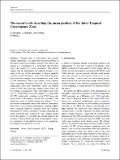| dc.contributor.author | Donohoe, Aaron | |
| dc.contributor.author | Ferreira, David | |
| dc.contributor.author | Marshall, John C | |
| dc.contributor.author | McGee, William David | |
| dc.date.accessioned | 2014-03-10T19:23:47Z | |
| dc.date.available | 2014-03-10T19:23:47Z | |
| dc.date.issued | 2013-05 | |
| dc.date.submitted | 2012-12 | |
| dc.identifier.issn | 0930-7575 | |
| dc.identifier.issn | 1432-0894 | |
| dc.identifier.uri | http://hdl.handle.net/1721.1/85592 | |
| dc.description.abstract | Through study of observations and coupled climate simulations, it is argued that the mean position of the Inter-Tropical Convergence Zone (ITCZ) north of the equator is a consequence of a northwards heat transport across the equator by ocean circulation. Observations suggest that the hemispheric net radiative forcing of climate at the top of the atmosphere is almost perfectly symmetric about the equator, and so the total (atmosphere plus ocean) heat transport across the equator is small (order 0.2 PW northwards). Due to the Atlantic ocean’s meridional overturning circulation, however, the ocean carries significantly more heat northwards across the equator (order 0.4 PW) than does the coupled system. There are two primary consequences. First, atmospheric heat transport is southwards across the equator to compensate (0.2 PW southwards), resulting in the ITCZ being displaced north of the equator. Second, the atmosphere, and indeed the ocean, is slightly warmer (by perhaps 2 °C) in the northern hemisphere than in the southern hemisphere. This leads to the northern hemisphere emitting slightly more outgoing longwave radiation than the southern hemisphere by virtue of its relative warmth, supporting the small northward heat transport by the coupled system across the equator. To conclude, the coupled nature of the problem is illustrated through study of atmosphere–ocean–ice simulations in the idealized setting of an aquaplanet, resolving the key processes at work. | en_US |
| dc.description.sponsorship | United States. National Oceanic and Atmospheric Administration (Postdoctoral Fellowship) | en_US |
| dc.description.sponsorship | United States. National Oceanic and Atmospheric Administration | en_US |
| dc.description.sponsorship | National Science Foundation (U.S.) | en_US |
| dc.language.iso | en_US | |
| dc.publisher | Springer-Verlag | en_US |
| dc.relation.isversionof | http://dx.doi.org/10.1007/s00382-013-1767-z | en_US |
| dc.rights | Article is available under a Creative Commons license; see publisher's site for details. | en_US |
| dc.rights.uri | http://creativecommons.org/ | en_US |
| dc.source | Springer | en_US |
| dc.title | The ocean’s role in setting the mean position of the Inter-Tropical Convergence Zone | en_US |
| dc.type | Article | en_US |
| dc.identifier.citation | Marshall, J., A. Donohoe, D. Ferreira, and D. McGee. “The Ocean’s Role in Setting the Mean Position of the Inter-Tropical Convergence Zone.” Climate Dynamics (May 1, 2013). | en_US |
| dc.contributor.department | Massachusetts Institute of Technology. Department of Earth, Atmospheric, and Planetary Sciences | en_US |
| dc.contributor.mitauthor | Marshall, John C. | en_US |
| dc.contributor.mitauthor | Donohoe, Aaron | en_US |
| dc.contributor.mitauthor | Ferreira, David | en_US |
| dc.contributor.mitauthor | McGee, David | en_US |
| dc.relation.journal | Climate Dynamics | en_US |
| dc.eprint.version | Final published version | en_US |
| dc.type.uri | http://purl.org/eprint/type/JournalArticle | en_US |
| eprint.status | http://purl.org/eprint/status/PeerReviewed | en_US |
| dspace.orderedauthors | Marshall, J.; Donohoe, A.; Ferreira, D.; McGee, D. | en_US |
| dc.identifier.orcid | https://orcid.org/0000-0001-9230-3591 | |
| mit.license | PUBLISHER_CC | en_US |
| mit.metadata.status | Complete | |
